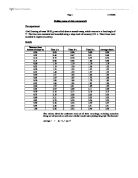Light is made up of Electro-magnetic waves of many different waveforms (incoherent). When directed through a plane, only that specific waveform of the light can pass through, this light has been polarized. A sugar solutions concentration is a very specific characterisation and rotates the plane polarized light a specific amount. The magnitude of polarization is proportional to the amount and mixture of sugar dissolved in the solution. This is the same for any optically active substance and so we can use the polarimeter to find the concentration of solutions or to see if the specific rotation of a solution is as published. A difference in specific rotation is a sure sign of material contamination.
A polarimeter works by first shining a light through a fixed polarizer to obtain just one plane of polarized light. This single plane of light is passed through a substance of know purity. The movable polarizer is adjusted so that the beam of light can be seen and left in this position. Next the sample for testing is placed in the polarimeter. If you can see the light, the sample has the same optical rotation to the standard. If not the movable polarizer can be adjusted to see the light, the specific rotation is then measured on the scale. Samples deviating from the published or specified rotation indicate the sample is not pure and has been tampered with either being diluted or made weaker; it has been “cut”.
http://mooni.fccj.org/~ethall/stereo/polarimeter.jpg
Refractometer
Refraction the fact or phenomenon of light, radio waves, etc. Being deflected in passing obliquely through the interface between one medium and another or through a medium of varying density.
[Oxford dictionary of English]
When something is placed in water, the end that is in the water appears to be bent. It appears to be even more bent however when placed in solutions. The angle that the object appears to be bent by is the angle of refraction; this can then be used to calculate the refractive index. The higher the refractive index the higher the concentration of the solution, e.g. sugar syrups.
Refractometers, devised by Dr. Ernst Abbe, are instruments which can be used to work out the concentration of water based solutions, by measuring the angle of refraction. In the food industry, sugar or salt solutions are measured this way. The refractometer utilises one of two systems, the older scale read transparent system and the newer digital reflection system. Using Snell’s Law of refraction, the refractive index of a substance can be obtained using the speed of light in a vacuum (v1) and also the speed of light in the substance (. The speed of light in two mediums and the angles of incidence and refraction are both directly proportional to the refractive index. Hence we can work out the refractive index of a substance using the angle of incidence (i) and the angle of reflection (r).
Refractive index = =
The Transparent System
A sample solution is placed on a prism of much greater refractive index than the sample. If the sample has a low concentration, the angle of refraction is large because there is a big difference in the refractive index between the prism and the sample. On the other hand if the sample has a high concentration, the angle of refraction will be small because it will be similar to that of the prism. The reading is shown on a scale as a dark shadow line.
The Reflection System
An LED is focused on the underside of the sample carrying prism face, some of this is lost as it is transmitted through the sample being tested but some is reflected back onto an array of photodiodes (a type of detector capable of converting light into a current) creating a shadow line.
As shown in the diagram light B is both refracted into the solution and then lost and also partly reflected back inside the prism. Lights A and C, Light A being totally refracted with none being reflected back and light C being totally reflected back into the prism, are both to the right of the reflected ray of light B. As a result a shadow line is formed; which is detected by the photodiodes and can then be converted into a refractive index using:
Refractive index =
The refractometers internal software can then convert this into a usable scale: oBrix for sugars solutions, oBaume for saline solutions. This shows the concentration percentage of the soluble solids content of the water based solution.
e.g. Brix Scale (sucrose)
http://www.coleparmer.com/techinfo/techinfo.asp?htmlfile=BrixScale.htm&ID=35
Refractometers are quick and reliable instruments, but do have limitations of accuracy depending on the temperature of the solution being measured. Temperature affects the solution density and thus the speed of the light passing through it. Correction tables are usually provided to amend the indicated brix/baume reading on older manual refractometers. Correction is automatic on more modern digital machines. The older transparent systems are limited in range and accuracy, the prisms operating in tight brix bands. One newer digital refractometer can replace several hand held prism refractometers.







